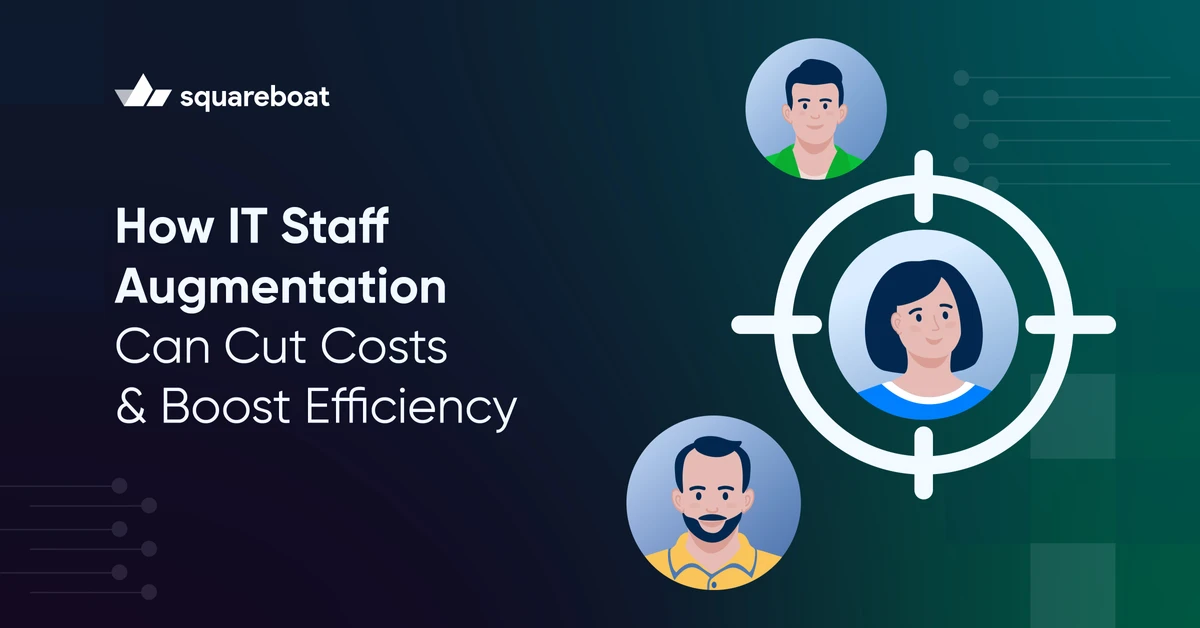The tech landscape is evolving faster than ever. With advancements in cloud computing, DevOps automation, and next-gen web development frameworks, the demand for niche talent has exploded. Traditional hiring models can’t keep up with the speed and specialization required today. That’s where IT Staff Augmentation comes in—a flexible, scalable solution that helps companies stay ahead of rapid digital transformation. As businesses push to modernize legacy systems, redesign platforms, or integrate cutting-edge technologies, the ability to plug in expert talent on demand is no longer optional—it’s strategic.
How IT Staff Augmentation Can Cut Costs and Boost Efficiency?
Scaling a tech team isn’t just about hiring fast—it’s about hiring smart. You skip recruitment bottlenecks, infrastructure expenses, and long onboarding cycles. Need a cloud-native DevOps expert or someone fluent in backend developer skills? They’re ready on demand. It’s especially valuable for companies juggling multiple types of software or rethinking product architecture during a website redesign. You get focused execution, improved output, and full control—without the operational drag that slows in-house-only teams.
How IT Staff Augmentation Can Cut Costs?
Hiring full-time tech talent isn't just expensive—it’s often inefficient. You pay for idle time, infrastructure, retention bonuses, and everything in between. With staff augmentation, you're cutting straight to productivity. Let’s break down how it actually cuts down costs:
1. Zero Recruitment Overhead
You skip job ads, LinkedIn posts, screening tests, and interview cycles. Augmented teams are pre-vetted and will be ready to be onboarded in hours—not weeks. This is especially helpful when working on rapid delivery models.
2. No Long-Term Financial Commitments
You don’t lock into yearly salaries, insurance, or appraisals. You pay for what you use, only for the duration you need—whether it's scaling frontend dev capacity or running a high-load microservices cluster.
3. Minimal Training & Onboarding Time
Specialists join with deep domain knowledge. Whether it's integrating wireframe examples into a sprint cycle or enhancing legacy systems, they’re already familiar with your tools and tech. That’s fewer delays and no hand-holding.
4. No Infrastructure or Seat Costs
These developers already have access to high-performance workstations, test suites, cloud environments, and IDEs. You don’t spend on workstations, VPNs, or in-house server setups.
5. Lower Operational Risks
You're not exposed to the financial risks of benching teams during slow quarters. The flexibility in scaling teams up or down based on sprint velocity or roadmap changes offers real-time cost control.
6. Global Cost Arbitrage
Access to talent in high-skill, low-cost regions allows significant budget optimization—without compromising code quality or sprint velocity. It’s a smarter choice than traditional outsourcing vs offshoring strategies where control is diluted.
How IT Staff Augmentation Can Boost Efficiency
Efficiency in tech projects doesn’t just come from hard work—it comes from having the right people in the right roles at the right time. That’s where staff augmentation makes a massive difference. It bridges critical talent gaps, fast-tracks delivery, and keeps projects moving without compromising quality. Here's how:
1. Immediate Access to Niche Expertise
Need someone experienced with DevOps tools or microservices deployment? Augmentation lets you plug in domain specialists without going through months of hiring cycles. This reduces onboarding time and eliminates the trial-and-error phase of building new features.
2. Seamless Scaling of Tech Teams
When deadlines tighten or scope expands, augmented resources step in without disrupting internal workflows. Whether you're building complex types of websites or scaling APIs, you can instantly match team size to project velocity.
3. Sharpened Focus on Core Competencies
Your in-house team stays focused on strategy, architecture, and innovation while augmented developers handle code execution, integrations, and testing. This focus boosts both delivery speed and product quality.
4. Improved QA Cycles and CI/CD Practices
Augmented engineers often come with solid exposure to automated testing, CI/CD pipelines, and performance monitoring. Their input improves release stability and reduces bugs—especially in time-critical sprints.
5. Faster Time-to-Market
From MVP development to rapid iterations, time is a major factor. Augmentation ensures shorter turnaround for deliverables without sacrificing reliability—vital when responding to software development trends or user feedback.
6. Global Coverage for 24/7 Development
Distributed augmented teams allow for round-the-clock development. You can hand off tasks at the end of your day and wake up to progress—especially helpful in sprints and when juggling deliverables across time zones.
7. Enhanced Collaboration with External Specialists
Bringing in outside talent exposes your team to new workflows, tools, and perspectives—especially useful when navigating projects involving UI vs UX refinements or complex system integrations.
8. Efficiency in Decision-Making and Execution
Augmented teams are project-focused. They're not bogged down by internal meetings or admin work. Their decisions are engineering-driven, which speeds up solutioning and execution—crucial in high-stakes builds.
9. Accelerated Prototyping and Innovation
With skilled specialists added to your team, experimenting with new features, frameworks, or outsourcing vs offshoring strategies becomes easier. Your internal team isn't stretched thin, and innovation doesn’t stall due to bandwidth issues.
Choosing the Best Partner for IT Staff Augmentation
Selecting the right partner isn’t just about filling roles. It’s about aligning technical depth, delivery speed, and domain understanding with your internal roadmap. A poor fit drains time, causes project delays, and creates friction across teams. The right partner integrates smoothly into your workflows, understands the nuances of agile delivery, and supports your long-term vision—from MVP builds to scaling enterprise-grade systems.
What to Look for in a Reliable Augmentation Partner:
- Strong Technical Vetting Process: Ensure their talent pool includes professionals tested on real-world engineering tasks, covering advanced frontend developer skills, secure system architecture, and scalable cloud deployments.
- Proven Track Record Across Industries: Your partner should have delivered across healthcare, fintech, logistics, or other verticals—each with its own set of security and compliance requirements.
- Seamless Integration Capabilities: Their developers should adapt easily to your sprint cycles, tools like Jira or Asana, and CI/CD pipelines—ensuring zero friction during handoffs or code merges.
- Transparent Communication and Escalation Models: Clarity on SLAs, project visibility, and dedicated account management is key—especially when working across distributed teams in different time zones.
- Focus on Long-Term Value: Great partners think beyond task completion. They contribute to architectural decisions, suggest optimization paths, and stay updated on software development trends to keep your product modern and future-proof.
- Scalability and Resource Availability: The ability to ramp up or replace resources fast is critical, especially when launching new modules or recovering from delivery setbacks.
When evaluating potential augmentation partners, treat them like you’d treat a co-founder for your project. It’s not just about coding—it's about collaboration, context, and continuous value.
Why Choose Crewmate for IT Staff Augmentation?
When it comes to scaling tech teams with speed and precision, Crewmate delivers more than just talent. We bring in pre-vetted, highly skilled engineers who can immediately plug into your workflow and accelerate your delivery timelines. Our deep focus on quality, technical alignment, and performance tracking makes us a trusted partner—not just a vendor.
Here’s why leading tech-driven businesses trust Crewmate:
1. Pre-Vetted Top 1% Talent
We handpick India’s best engineers, product managers, and UI/UX designers after a rigorous multi-stage evaluation process. Every profile is assessed for backend developer skills, system design, problem-solving, and clean coding practices.
2. Fast Onboarding – Under 48 Hours
Time-to-hire is critical. Our talent pool is ready to deploy. Whether you're short on frontend developer skills or need cloud-native DevOps engineers, we integrate experts within days, not weeks.
4. Deep Technical Expertise
We specialize in complex builds. From types of websites like eCommerce, SaaS, and enterprise portals to high-scale microservices and cloud-based applications—we match your project with engineers who’ve done it before.
5. Flexibility Without Overhead
Scale teams up or down based on sprint velocity or roadmap priorities. Avoid long-term contracts, infrastructure spending, or fixed employee costs—unlocking one of the key benefits of IT staff augmentation.
6. Integrated Project Management
Our engineers are experienced in tools like Jira, Trello, GitLab, and CI/CD pipelines. We also provide ongoing support, feedback loops, and performance reviews to ensure your roadmap stays on track.
7. Cultural & Time Zone Compatibility
We align developers who sync with your team’s timezone, communication style, and delivery culture. Whether you're in the US, UK, or APAC, collaboration remains seamless.
8. Strategic Alignment with Trends
Our teams stay updated on software development trends, popular DevOps tools, and the evolving landscape of UI vs UX design, making sure you’re never behind the curve.
9. Tailored Roles for Every Use Case
Need a scalable DevOps pipeline? A product revamp? A mobile-first UI refresh? We assign roles across types of software projects—web, mobile, embedded, or cloud-native—with laser precision.
10. Transparent Pricing, Zero Surprises
No long contracts. No bloated invoices. Our pricing is clear, predictable, and based on actual usage. You only pay for value delivered.
Crewmate doesn’t just fill gaps—it powers growth. We’re not an outsourcing shop. We’re your strategic partner in building high-performance teams that understand scale, speed, and stability.
Let Crewmate turn your hiring bottlenecks into delivery speed boosts—seamlessly.
Conclusion
IT staff augmentation is no longer just a hiring shortcut—it’s a strategic, technical decision. It lets you plug in experts with niche skills exactly when needed, whether it’s frontend developer skills, backend developer expertise, or DevOps tools. You avoid long hiring cycles, reduce fixed costs, and keep delivery timelines on track. It aligns perfectly with today’s software development trends, especially when building complex systems using modern web development frameworks or working on a full website redesign. Whether you're scaling fast or bridging a short-term gap, augmentation keeps your tech roadmap moving leaner, faster, and smarter.
Frequently Asked Questions
Q. How does IT staff augmentation differ from outsourcing or offshoring?
Staff augmentation adds skilled developers to your in-house team, giving you control over workflows—unlike outsourcing vs offshoring, where entire projects are handed off externally.
Q. Can I augment my team with developers skilled in specific tech stacks?
Absolutely. You can onboard experts in web development frameworks, cloud-native DevOps, frontend developer skills, or even niche backend developer skills based on project needs.
Q. Will staff augmentation speed up my product development cycle?
Yes. Augmented teams come project-ready, cutting onboarding time and boosting velocity—perfect for fast-moving software development trends and MVP builds across types of websites.
Q. How do I know if my business needs IT staff augmentation?
If your internal team lacks bandwidth or domain depth—be it UI/UX, DevOps tools, or cross-platform mobile—you need flexible scale. That’s where augmentation fits.
Q. Is staff augmentation suitable for design and product roles too?
Definitely. You can bring in UI/UX designers skilled in prototyping, wireframe examples, or even someone who understands the difference between UI UX designer and web designer.


